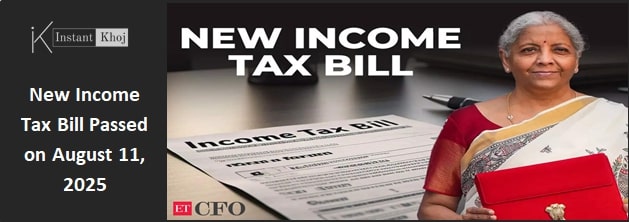India’s Income Tax Landscape
For decades, India’s income tax system has been governed by the Income Tax Act of 1961. Over time, multiple amendments and additions turned the law into a complex framework that was difficult for both taxpayers and administrators to navigate. Calls for reform have grown louder in recent years, with the need for a simpler, more transparent, and digitally aligned system.
The Bill and Its Passage
On August 11, 2025, Parliament passed the Income-tax (No. 2) Bill, 2025, which will replace the 1961 Act. The original draft of the bill, introduced in February 2025, was referred to a Parliamentary Select Committee. After receiving more than 200 suggested amendments and extensive public feedback, the draft was withdrawn on August 8 and reintroduced in a revised form just days later.
The revised bill was passed in the Lok Sabha on August 11 and cleared the Rajya Sabha the following day. While the bill’s approval was swift, it drew some criticism because it was passed without debate due to ongoing disruptions in Parliament.
Key Features of the New Law
1. Simplification and Structure
-
The number of sections has been reduced from over 800 to 536, and chapters have been cut from 47 to 23.
-
The overall length of the law has been halved, making it easier to read and understand.
-
A new concept of the “Tax Year” replaces the earlier dual structure of “Previous Year” and “Assessment Year,” ensuring that income earned and taxed follows the same April–March cycle.
2. Clarity on Exemptions and Deductions
-
Commuted pensions from approved funds such as LIC and NPS will now clearly qualify for full tax exemption.
-
Provisions for house property deductions and pre-construction interest have been written more explicitly into the law.
3. Refunds and Penalties
-
Taxpayers who file returns after the deadline will still be eligible for refunds, a relief compared to earlier restrictions.
-
The government can waive penalties in cases where the law previously did not allow such discretion.
-
Nil TDS (Tax Deducted at Source) certificates will now be available to all residents, regardless of age.
4. Digital Compliance and Modernization
-
Broader definitions now cover virtual digital assets, including cryptocurrencies and NFTs, ensuring they fall under tax reporting rules.
-
The bill strengthens faceless and digital assessment procedures, reducing the need for in-person interactions with tax officials.
Who Will Be Affected
-
Salaried Individuals: Benefit from clearer rules, simpler provisions, and easier compliance.
-
Pensioners: Gain clarity on commuted pension exemptions.
-
Property Owners: Enjoy a more transparent framework for interest deductions on let-out properties.
-
Businesses and Startups: Must adapt to expanded definitions, especially around digital assets, and comply with stricter reporting standards.
-
Tax Authorities: Equipped with updated tools for monitoring and enforcement, though concerns remain about the scope of their powers.
Government’s Objectives
The new bill has several stated goals:
-
To simplify India’s tax structure and cut down on excessive legal complexity.
-
To widen the tax base by including new categories such as digital assets.
-
To ease compliance, especially for individuals and small businesses, through plain language and reduced red tape.
-
To modernize tax administration with digital systems and faster dispute resolution.
Reactions and Likely Impact
The lack of debate during its passage has raised concerns among some lawmakers and observers, who believe a bill of such importance deserved more discussion. However, tax professionals have generally welcomed the reforms, noting that the changes bring long-awaited clarity in areas like pensions, property income, and refunds.
For taxpayers, the reforms promise simpler compliance and faster resolution of refund issues. For the government, the new framework is expected to improve compliance rates and potentially increase revenue. At the broader level, the move is seen as part of India’s ongoing efforts to create a tax system that supports economic growth while reducing unnecessary complexity.
Conclusion
The Income-tax (No. 2) Bill, 2025 marks a historic shift by replacing a six-decade-old law with a modern, streamlined framework. By simplifying language, clarifying exemptions, and embracing digital processes, the bill seeks to make taxation more transparent and taxpayer-friendly. While questions remain about implementation and compliance challenges for certain groups, the reform represents an important milestone in aligning India’s tax system with the needs of a fast-growing economy.
Disclaimer: This article is based on publicly available information as of August 2025 and is intended for general informational purposes only. For the most accurate and updated details, readers are advised to visit the official website of the Income Tax Department of India at www.incometaxindia.gov.in or consult with a qualified tax professional.
Read more articles like this — Click here to explore now





One thought on “New Income Tax Bill Passed on August 11, 2025”